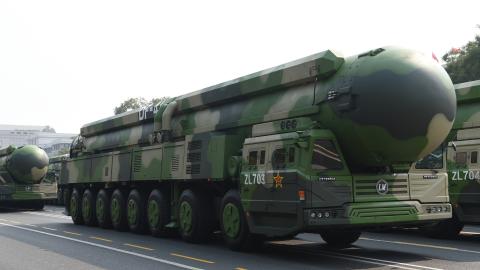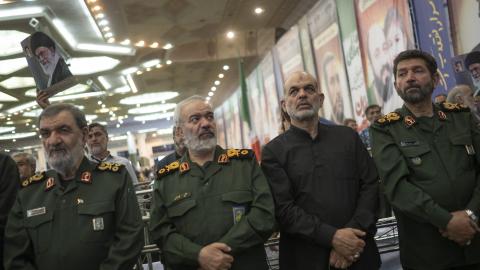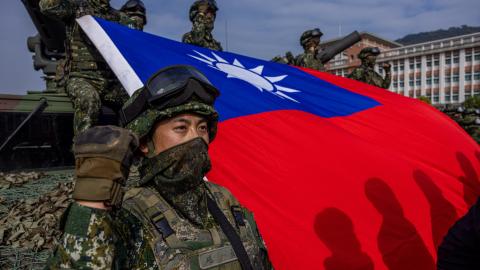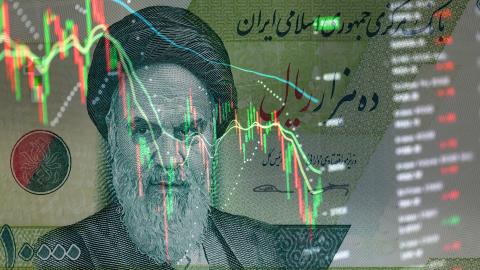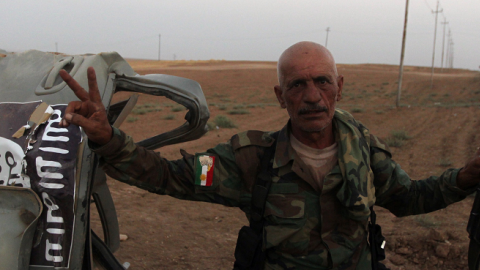The Islamic State in Iraq and Syria, the terrorist army many thousand strong now rampaging through the Levant, embraces such an extreme, violent ideology that it makes even al Qaeda squeamish, argue many Western experts. On this reading, al Qaeda leader Ayman al Zawahiri was forced to distance himself from ISIS’s bloody practices. In reality, the notion that ISIS’s gory campaign turns the stomach even of an arch-terrorist, America’s public enemy number one, is colorful but inaccurate.
To be sure, ISIS—or the Islamic State, as it now calls itself—is an extremist movement, attracting militants from all over the world eager to help build the new caliphate. Given the thousands of foreigners—including Chechen snipers, Saudi car bombers, and Western misfits like American Douglas McAuthur McCain—who have signed on to fight alongside ISIS, security officials are right to fear that the United States will become an ISIS target. The group kidnaps and murders American journalists. It threatened the existence of the Yazidi community in Iraq, and it slaughtered at least 700 members of the Sheitat, a tribe in Syria, last month. It regularly employs the vicious hudud punishments to enforce sharia law in the areas it controls in Syria and Iraq.
None of this, however, is outside the norms of a region where governments regularly incite hatred of America and Israel, wage wars against their own populations, and kidnap, imprison, and kill foreign nationals. Cutting off the hands of criminals, as prescribed by sharia, is hardly out of the ordinary; the Islamic Republic of Iran hangs gay teenagers from construction cranes, and the legal authorities of Saudi Arabia—an American ally—regularly separate accused criminals from their heads in public executions in what is popularly known as Chop-Chop Square.
What’s extraordinary about ISIS is not the violence. Indeed, the reason Zawahiri denounced the group was not its cruelty but its refusal to follow his orders and merge with another extremist organization. In other words, the dispute between ISIS and al Qaeda was not about the conduct of the former but about who was in charge, a regular feature of regional power dynamics.
Nor are ISIS’s money-raising schemes especially novel in the Middle East. As the Wall Street Journal reported last week, the organization’s key source of income is oil, especially in the Syrian provinces of Deir al-Zour and Raqqa and the Iraqi province of Nineveh. “They sell it to opposition groups, to the tribes, back to the Syrian regime, or on the Iraqi black market,” says Faysal Itani, an ISIS expert at the Atlantic Council. The other main source of revenue is taxation, or rather, extortion. As one source in the city of Raqqa, ISIS’s so-called capital, explained to us, merchants pay 3,000 Syrian pounds (close to $20) every two months. The kidnapping of foreigners or wealthy Syrians for ransom also brings in millions.
And yet it’s true that ISIS is not exactly what we’ve become accustomed to seeing in the Middle East of late. “This is not a classic insurgency,” says Itani, “or a non-state actor. Rather, it’s a state-building organization.” ISIS’s effort right now is to secure borders and lines of communication. Comparing ISIS’s project with al Qaeda’s, Itani notes that bin Laden’s logic was to draw the United States into conflict with the Muslim world in the hope of making the people so disgusted with their regimes that al Qaeda could take over. ISIS is different: It aims to take territory, hold it, and build a state. That is, at a moment when much of the rest of the Middle East is moving toward chaos, the Islamic State is consolidating.
ISIS’s leader, Ibrahim Awwad al-Badri, is the self-proclaimed caliph, also known as Abu-Bakr al-Baghdadi, a 43-year-old jihadist from the Iraqi city of Samarra. During the American occupation, he was arrested on unclear charges, but deemed a low security threat and released after six months. Once out of jail, he joined Al Qaeda in Iraq, then under the leadership of the Jordanian Abu Musab al Zarqawi. Long before he proclaimed his caliphate, Baghdadi came to understand something that was lost on Zarqawi. As a member of the Banu Badr clan, Baghdadi saw that he needed to court the tribesmen on both sides of the Iraqi-Syrian border.
His strategy was greatly facilitated by the Obama administration’s December 2011 withdrawal from Iraq and the anti-Sunni policies pursued by the Shiite-dominated government in Baghdad. ISIS’s project was further aided by the Syrian uprising, which began in March 2011. Over the last three and half years, it has evolved into a civil war in which Syrian president Bashar al-Assad has slaughtered Sunnis. The White House and the rest of the international community have done nothing to stop him.
In other words, any policy addressing ISIS also has to address the root problem: What gave ISIS room to take hold and blossom is the Iranian-backed order of the Levant, consisting of Hezbollah in Lebanon, Bashar al-Assad in Syria, and Nuri al-Maliki and his successor, Haidar al Abadi, in Iraq. All these are sustained by the Shiite Islamic revolutionary regime in Tehran. And the White House has virtually signed onto this regional security apparatus. It is the tacit agreement the Obama administration has made with Tehran that has not only galvanized ISIS but also made foes out of former allies. Sunni Arab tribes that sided with the United States during the surge to defeat Al Qaeda in Iraq less than a decade ago are now joining the Sunni extremists of ISIS.
Western commentators often marvel that ISIS, unlike other terrorist organizations, is capable of mounting serious military campaigns. For instance, in a June 10 blitzkrieg, ISIS units stormed Iraqi military bases and police stations in the country’s second-largest city of Mosul. The fighters swept through Nineveh, most of Salaheddine, and parts of Diyala provinces. They linked up with tribal fighters from Anbar Province who had been in revolt against the government of Nuri al-Maliki for months. The reason ISIS and its allies seem to operate like a real army is that their military council is made up of former officers from an Arab army—Saddam Hussein’s.
Accordingly, it might be most useful to see the current sectarian conflagration tearing through the Middle East as an extension of the Iran-Iraq war. After that nearly decade-long conflict (1980-1988), Saddam Hussein, ever fearful of coups, liquidated senior army officers who’d emerged from the war as heroes. One such officer was his cousin, childhood friend, and brother-in-law, Defense Minister Adnan Khairallah Talfah. Having thus hollowed out the Iraqi army, Saddam built special units, like the Republican Guards and Fedayeen Saddam, that were well trained in espionage work and explosives. After the U.S.-led invasion in 2003, some of these officers, along with others from Saddam’s M4 directorate of the Iraqi intelligence service, joined the insurgency against coalition forces and Iraq’s new Shiite-dominated ruling order, which from their perspective was a collaborative American and Iranian affair.
On the other side, Tehran’s first order of business in 2003 after Saddam had been toppled was to take revenge on the Iraqi military and intelligence personnel the Iranians had fought in the 1980s. Many of Iran’s allies in Iraq—including, some say, former prime minister Maliki—formed death squads to go after these officers. Saddam’s onetime officer corps went into hiding and used their expertise and money to wage war against the regime that had replaced them. When the United States, in partnership with major Sunni tribes, defeated the Sunni insurgency, American officials pleaded with Maliki to stop hunting the former Baathists and allow them to resettle peacefully in a post-Saddam Iraq. Maliki didn’t, nor did his allies. Iranian Revolutionary Guard Corps officers like Quds Force commander and Iran-Iraq war veteran Qassem Suleimani as well as Iranian-backed militias like Asa’ib ahl al-Haq continued to prosecute their war against Iraq’s Sunni community. Eventually the Sunnis came to see ISIS as one of their few lines of defense against this Shiite persecution.
Today, some of these former Iraqi officers constitute ISIS’s core military leadership. As the New York Times reported last week, the last two heads of ISIS’s military council were officers under Saddam, as was the current head of ISIS’s military operations, Adnan al-Sweidawi, also known as Abu Ayman al-Iraqi, who worked as a colonel in Saddam’s air defense intelligence unit. Other former Saddam loyalists have fought alongside ISIS. They include Jaysh Rijal al-Tariqah al-Naqshbandiyah (JRTN), a well-trained group of former Iraqi intelligence and army officers, led by Ibrahim Izzat al-Douri, a former high-level Baath party official. Douri was the king of clubs in the U.S.-led coalition’s deck of playing cards of most-wanted Iraqi officials, yet he evaded American forces. It was reportedly JRTN that provided the main muscle in ISIS’s takeover of Mosul in June.
The other key players in the ISIS-led Sunni rebellion are the Arab tribes on both sides of the Syrian-Iraqi border. Indeed, the map of ISIS’s new caliphate, with its so-called capital in Raqqa and encompassing Deir al-Zour in Syria and Nineveh, Anbar, Salaheddine, and Diyala in Iraq, overlays a much older map of tribal lands forming a contiguous territory with a total area of around 168,000 square miles, bigger than Great Britain (143,000 square miles). To see how ISIS has succeeded, it is of paramount importance to understand the tribal politics behind its achievement.
ISIS’s first success in tribal politics was in Raqqa, which it snatched from the hands of the Assad regime and turned into its capital. Until the middle of 2013, Raqqa remained loyal to Assad. Although few Syrian security forces were present in the city, and the capital, Damascus, is nearly 300 miles away, making it virtually impossible to maintain communications and supply lines, Raqqa remained in Assad’s control because the city was run by the Sharabeen tribe.
In the tribal world, the Sharabeen are not part of the elite. They are a cattle-raising tribe, considerably less prestigious than, say, the camel-raising Shammar, one of the biggest tribes in the Middle East, whose members are known for their valor. When the founder of modern Saudi Arabia, Abdul-Aziz Ibn Saud, defeated the Shammar in 1910, the tribe pledged allegiance to him. Even as the British and French forced Ibn Saud to relinquish much of the Shammar territory he’d won, the Saudi king issued many Shammar Saudi passports.
Former Syrian president Hafez al-Assad, father of Bashar, well understood the significance of the ties between the Shammar and the Saudis. To counter Saudi influence in Raqqa, he propped up the Sharabeen, funding them, arming them, and giving them government jobs. All this came at the expense of the Shammar, many of whom picked up and moved to Saudi Arabia. When the anti-Assad rebellion erupted in 2011, Riyadh sent some Shammar tribal leaders back to Syria, like onetime head of the Syrian National Council Ahmed al-Jarba. The potential return of the powerful Shammar became a pressing concern not just for the Sharabeen, but for other tribal groups as well, which is what prompted 14 Raqqa clans to pledge allegiance to ISIS in November 2013. This is how Raqqa turned, quickly and peacefully, from an Assad stronghold into ISIS’s capital.
Baghdadi repeated the same exercise in Syrian border towns like Al-Qaim and Bou Kamal, as well as Al-Omar, which is Syria’s largest oil field, in Deir al-Zour Province. The Iraqi native had an even easier time with tribal politics on the Iraqi side of the border.
When British diplomat Gertrude Bell assembled modern Iraq, it was with an eye to securing a pipeline that linked the oil fields of Basra, in southern Iraq, to the Port of Haifa, in northern Palestine. This required integrating the Dulaim, an enormous tribe of around three million people today, and its territory, Dulaim Province, into Iraq. The Dulaimis would produce two Iraqi presidents, the last of whom was deposed by the Baathists, who changed the name of Dulaim Province to Anbar. Between 1993 and 1996, the CIA reportedly encouraged the Dulaimis to revolt against Saddam, which they did, and, losing, paid dearly. Nonetheless, one of the leading clans of the Dulaim, the Abu Risha, came to ally itself with the United States during the occupation, and without them, the coalition forces almost certainly would not have won the surge.
Maliki alienated the tribes that the surge had won over. He refused to share power with them. After the Obama administration’s December 2011 withdrawal, the tribes—including the Dulaim—defied Maliki by holding anti-government rallies inspired by the Arab Spring. When Maliki cracked down on protesters and his forces ejected Sunni leaders from the government, the tribes went into open revolt.
To be sure, not all the Iraqi tribes have pledged allegiance to the new caliph, though they are fighting government forces alongside ISIS. Even as Baghdadi tried to woo some clans from the Dulaim, the tribe’s leader, Sheikh Ali al-Hatem, a former Awakening Council member and a staunch opponent of the Iraqi government, stood up to Baghdadi and kept him out of most of Anbar’s towns, including the biggest, Ramadi.
Perhaps eventually, the various components of the Sunni rebellion—the Dulaim, the Shammar, JRTN, ISIS, and the rest—will turn on each other. Already clashes have erupted between them, over booty or territory. But it is still too early for them to fall into open conflict. With ISIS spearheading the effort, the Sunni rebellion will likely continue to grow.
Last week President Obama announced that the White House has no policy to deal with ISIS. The revelation came as no surprise since it was the administration’s handling of Iraq and Syria that gave ISIS room to grow. Before tackling the problem of Sunni extremism, the administration needs to address the pro-Shiite, pro-Iranian extremism that led to it. Even if the administration wanted to address the root causes of the Sunni rebellion, it has little power to affect facts on the ground: It took its troops and went home in 2011. The Iranians, by contrast, through their allies and through the military assets they are willing to use, from Hezbollah to the Iranian Revolutionary Guard Corps, have lots of leverage. Iraq’s new prime minister, Haidar al-Abadi—named to the post by Quds Force commander Suleimani—is every bit as much an Iranian asset as Maliki was.
But the reality is that Obama doesn’t want to change the equation. As the president has explained in a series of interviews over the last year, he wants to build a new geopolitical equilibrium that would bring Iran back into the community of nations. And to do that, the White House has to respect Iranian regional interests—which amounts to signing off on Iranian hegemony across the Levant, at the expense of America’s traditional regional partners, the Sunnis.
What’s most extraordinary about the Middle East at present isn’t ISIS and the rest of the Sunni rebellion. Rather, it’s the Obama administration’s inability to formulate a policy that would protect American interests by pushing back against Iran’s project for the region. Instead, the White House is squared off against traditional American allies in a way we’ve never seen before—with the Sunnis now galvanized by a 4,000-year-old tribal code and led by a caliph.
This article appears in the September 8, 2014, Vol. 19, No. 48 issue of The Weekly Standard.


